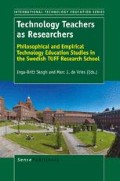Abstract
Problem solving is the fundament of all applied disciplines in Science and Technology, where theoretical understanding is necessary for knowledge progression and systematic structuring of a task is the key to how to solve the problem.
Access this chapter
Tax calculation will be finalised at checkout
Purchases are for personal use only
Preview
Unable to display preview. Download preview PDF.
References
Anthony, G., & Walshaw M. (2009). Characteristics of effective teaching of mathematics: A view from the West. Journal of Mathematics Education, December 2009, 2(2), 147–164.
Bergsten, C., Häggström, J., & Lindberg, L. (1997). Algebra för alla. Nämnaren TEMA. Gothenburg: NCM, University of Gothenburg.
Björk, L. E., Brolin, H., & Munther, R. (2000). Matematik 3000 – Gymnasieskolan Grundbok, kurs A / Matematik tretusen. Stockholm: Natur och Kultur.
Curcio, F. R., (1987). Teaching and learning: a problem-solving focus; an anthology. National council of teachers of mathematics. Reston, VA.
Emanuelsson, G., Johansson, B., & Ryding, R. (1991). Problemlösning. Lund : Studentlitteratur.
Emanuelsson, G., Wallby, K., Johansson, B., & Ryding, R. (red.) (2000). Matematik ett kommunikationsämne. Nämnaren TEMA, Gothenburg: NCM, University of Gothenburg.
Encyclopedia Britannica Academic Edition. (2011). Problem solving in Egypt and Babylon. Available: http://www.britannica.com/EBchecked/topic/14885/algebra/230957/Problem-solving-in-Egypt-and-Babylon.
Feinstein, S. (2006). The Praeger handbook of learning and the brain (Vol. 2). Greenwood Press, USA.
Fraivillig, J., Murphy, L., & Fuson, K. (1999). Advancing children’s mathematical thinking in Everyday Mathematics classrooms. Journal for Research in Mathematics Education, 30, 148–170.
Gordon, S. (1997). Functioning in the real world: A precalculus experience. New York: Addison Wesley.
Hagland, K., Hedrén, R., & Taflin, E. (2005). Rika matematiska problem: Inspiration till variation. Stockholm: Liber.
Hiebert, J., & Lefevre, P. (1986). Conceptual and procedural knowledge in mathematics. An introductory analysis. In J. Hiebert (Ed. ), Conceptual and procedural knowledge: The case of mathematics (pp. 1–27). Hillsdale, NJ: Erlbaum.
Idris, N. (2009). Enhancing students’ understanding in calculus. International Electronic Journal of Mathematics Education, 4(1), February 2009.
Löwing, M., & Kilborn, W. (2002), Baskunskaper i matematik för skola, hem och samhälle. Lund: Studentlitteratur.
Malmer, G. (1990). Kreativ matematik. Solna: Ekelunds förlag.
Malmer, G. (1999). Bra matematik för alla. Nödvändig för elever med inlärningssvårigheter. Lund: Studentlitteratur.
Miller, L. D. (1992). Begin mathematics class with writing. Mathematics Teacher, 85(5), 354–355.
Oaks, A., & Rose, B. (1992). Writing as a tool for expanding student conception of mathematics. Paper presented at the 7th International Congress on Mathematics Education. Working Group 7: Language and Communication in the Classroom, Quebec.
Pólya, G. (1957). How to solve it, Princeton University Press.
Sarrazy, B. (2003). Le problème d’arithmétique dans l’enseignement des mathématiques à l’école primaire de 1887 à 1990. Carrefours de l’éducation. n°15. janvier-juin 2003.
Skolverket (1994a). Läroplan för det obligatoriska skolväsendet, förskoleklassen och fritidshemmet Lpo 94. Stockholm: Fritzes.
Skolverket (1994b). Läroplan för de frivilliga skolformerna, Lpf 94. Stockholm: Fritzes.
Skolverket (2011a). Gymnasial utbildning – Matematik A. Available: http://www.skolverket.se/sb/d/2919/a/16428, redirected to http://www.prim.su.se/matematik/kurs_a/prov_vt2010/Del1.pdf.
Skolverket (2011b). Gymnasial utbildning – Matematik A. Available: http://www.skolverket.se/sb/d/2919/a/16428,redirected tohttp://www.prim.su.se/matematik/kurs_a/prov_vt2010/BedAnvDel1.pdf.
Stanford Encyclopedia of Philosophy (2011). Aristotle and Greek Mathematics. Available: http://plato.stanford.edu/entries/aristotle-mathematics/supplement4.html
Editor information
Editors and Affiliations
Rights and permissions
Copyright information
© 2013 Sense Publishers
About this chapter
Cite this chapter
Nordlander, E., Nordlander, M.C. (2013). The Noble Art of Problem Solving. In: Skogh, IB., Vries, M.J.D. (eds) Technology Teachers as Researchers. International Technology Education Studies, vol 10. SensePublishers, Rotterdam. https://doi.org/10.1007/978-94-6209-443-7_6
Download citation
DOI: https://doi.org/10.1007/978-94-6209-443-7_6
Publisher Name: SensePublishers, Rotterdam
Online ISBN: 978-94-6209-443-7
eBook Packages: Humanities, Social Sciences and LawEducation (R0)

